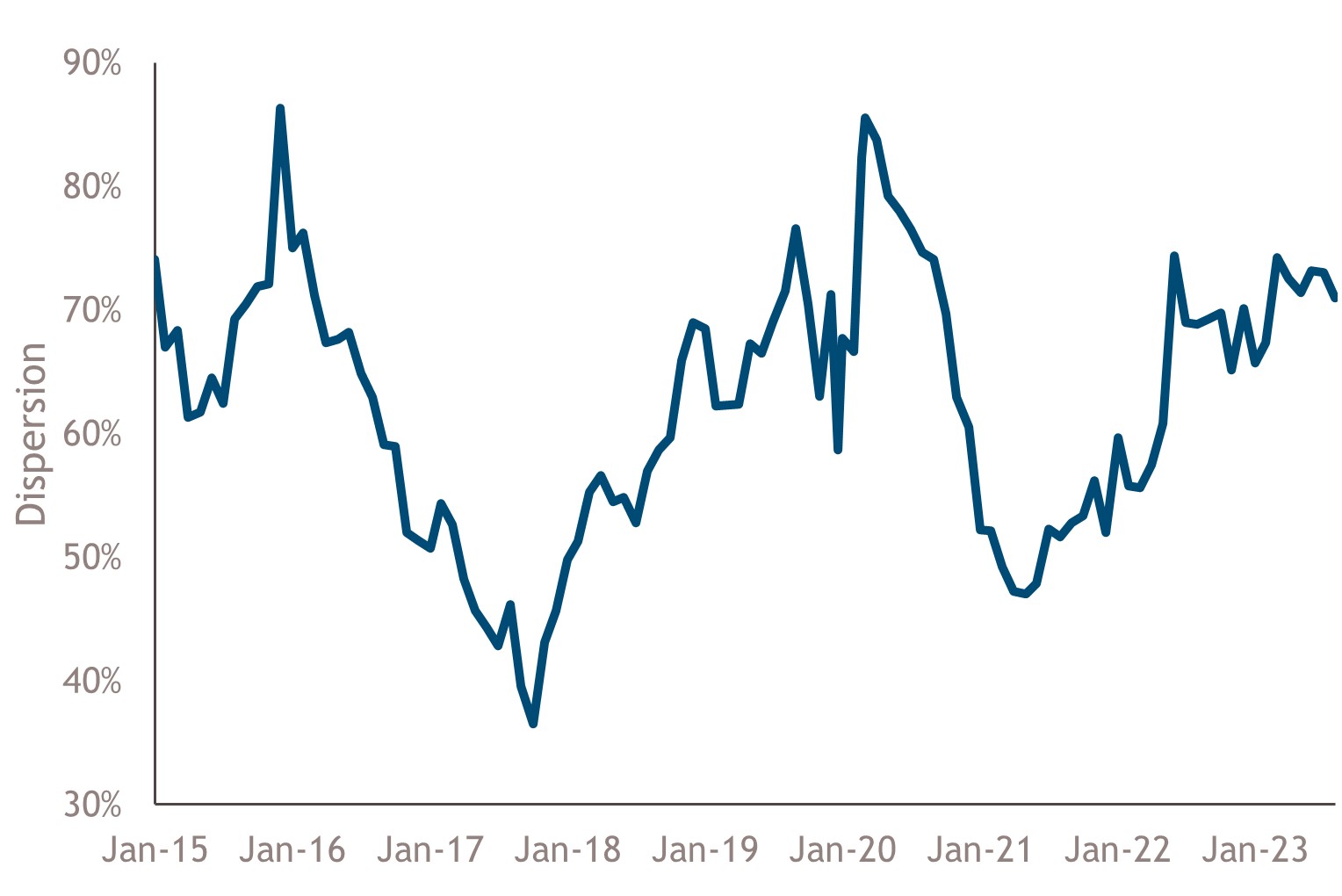Insight | August 4, 2023
US High Yield – Different This Time Around?
It’s been a strong year for US high yield with the market up close to 7% year to date1. Returns have been solid relative to higher rated fixed income with spreads of circa 400bps - a level last seen in April 2022 at the onset of the Federal Reserve rate hiking cycle – being inside their long-term averages yet well above the 250-300bps lows experienced over the last 20 years. Investors have asked if current spreads offer appropriate compensation in this era of high rates and medium-term recession concerns.
What is compelling about the situation this year is an attractive yield-to-worst which exceeds 8%. This yield is usually associated with much higher levels of credit and default risk than we believe is justified by the underlying economic data. In fact, over the last 20-years investors have only been rewarded with yields consistently over 8% during high stress periods.
Fig. 1 – 20 Year Yield to Worst
 Source: ICE Data Platform, ICE BofA US High Yield Index (J0A0), as of 30th June 2023. For illustrative purposes only.
Source: ICE Data Platform, ICE BofA US High Yield Index (J0A0), as of 30th June 2023. For illustrative purposes only.
Strong Technical Demand
While the US high yield market has experienced significant growth over the past two decades, since 2016 it has only grown c. 4% (Fig. 2). For example, issuers only brought US$5.9bn across 10 deals to market in July, an amount that doesn’t even cover the average monthly coupon of US$6.5bn. This means investors are not being overwhelmed by new paper.
Fig. 2 - Face Value of US High Yield, Investment Grade and Leveraged Loans (USD millions)

The market has also been in net deficit since 2021 (Fig. 3). Net rising stars have been the driving force behind this situation with over US $200 billion of net rising stars during this period; a factor demonstrating the good credit quality of the asset class.
Fig.3 – Sources of Supply and Demand (US$bn)
 Source: JP Morgan High Yield and Leveraged Loan Monitor, 5th July 2023. For illustrative purposes only.
Source: JP Morgan High Yield and Leveraged Loan Monitor, 5th July 2023. For illustrative purposes only.
Improving Credit Quality
Based on figure 3, US BB bonds are near 20-year highs while the number of CCC-rated bonds has been falling for some time and are near a 20-year low. US high yield is on an improving credit trajectory while other US corporate credit markets are absorbing higher risk as measured by lower rated bonds in their asset class.
Fig. 4 – Ratings Migration
 Source: ICE Index Platform, as June 30th, 2023. ICE BofA US Cash Pay High Yield Index (J0A0), ICE BofA CCC and Lower US Cash Pay High Yield Index (J0A3), ICE BofA BB US Cash Pay High Yield Index (J0A1), ICE BofA US Corporate Index (C0A0), ICE BofA US BBB Corporate Index (C0A4) and Credit Suisse Leveraged Loan Index. For illustrative purposes only. Chart shows the face value of the J0A1 and J0A3 Indices as a % of the face value of the J0A0 Index, going back monthly for the past 20 years. Shaded areas represent recession periods. Indices selected as best available proxy to measure relative breakdown of rated bonds.
Source: ICE Index Platform, as June 30th, 2023. ICE BofA US Cash Pay High Yield Index (J0A0), ICE BofA CCC and Lower US Cash Pay High Yield Index (J0A3), ICE BofA BB US Cash Pay High Yield Index (J0A1), ICE BofA US Corporate Index (C0A0), ICE BofA US BBB Corporate Index (C0A4) and Credit Suisse Leveraged Loan Index. For illustrative purposes only. Chart shows the face value of the J0A1 and J0A3 Indices as a % of the face value of the J0A0 Index, going back monthly for the past 20 years. Shaded areas represent recession periods. Indices selected as best available proxy to measure relative breakdown of rated bonds.
Increasing Amount of Secured Debt
Perhaps a surprising phenomenon is the increase in the amount of secured debt in the asset class over the last four years – from c. 18% in 2019 up to a record high of 30% today. These instruments tend to have higher recovery rates than unsecured bonds in the event of a default and improve the quality of the underlying issuers.
Fig. 5 – Increase in % of Secured Debt

Source: ICE Data Platform, ICE BofA US High Yield Index (J0A0), as of 30th June 2023. For illustrative purposes only.
Summary
Recessionary risks, inflation and higher rates have dominated markets for much of the year, which would justify elevated yields as compensation. Nevertheless, a slew of better-than-expected macro data and signs of falling inflation we believe are increasing the likelihood the Federal Reserve may soon reach the end of their hiking cycle and achieve a soft landing, justifying current spread levels. The economy is healthier than expected and yet investors are receiving high yields without commensurable risk.
Yield and carry are the name of the game right now, especially if longer rates trend higher due to good economic numbers. We may reassess this situation if the economic data weakens materially or if the FOMC surprises with strongly hawkish decisions. However, betting on weakness now seems riskier than being invested in an improved asset class yielding up to 8% given the economic data and a Fed that is finishing its rate hiking programme.
1.ICE Data Platform, ICE BofA US High Yield Index (J0A0), as of 31st July 2023
Past performance is not a reliable indicator of current or future result.
This material is not intended to be relied upon as a forecast, research, or investment advice, and is not a recommendation, offer or solicitation to buy or sell any securities or to adopt any investment strategy. The opinions expressed by Muzinich & Co are as of July 2023 and may change without notice.
-----------------------------------------------------------------------------------------------------------------------------------------------------------------------------------------------------------------------------------------
Index Descriptions
J0A0 - The ICE BofA ML US Cash Pay High Yield Index tracks the performance of US dollar denominated below investment grade corporate debt, currently in a coupon paying period that is publicly issued in the US domestic market. Qualifying securities must have a below investment grade rating (based on an average of Moody’s, S&P and Fitch), at least 18 months to final maturity at the time of issuance, at least one year remaining term to final maturity as of the rebalancing date, a fixed coupon schedule and a minimum amount outstanding of $250 million.
J0A1 – The ICE BofA ML BB US Cash Pay High Yield Index is a subset of the ICE BofA ML US Cash Pay High Yield Index (J0A0) including all securities rated BB1 through BB3, inclusive.
J0A3 – The ICE BofA ML CCC & Lower US Cash Pay High Yield Index is a subset of the ICE BofA ML US Cash Pay High Yield Index (J0A0) including all securities rated CCC1 or lower.
C0A0 - The ICE BofA ML US Corporate Index tracks the performance of US dollar denominated investment grade corporate debt publicly issued in the US domestic market. Qualifying securities must have an investment grade rating (based on an average of Moody’s, S&P and Fitch), at least 18 months to final maturity at the time of issuance, at least one year remaining term to final maturity as of the rebalancing date, a fixed coupon schedule and a minimum amount outstanding of $250 million.
C0A4 - The ICE BofA ML BBB US Corporate Index is a subset of the ICE BofA ML US Corporate Index (C0A0) including all securities rated BBB1 through BBB3, inclusive.
Important Information
Muzinich and/or Muzinich & Co. referenced herein is defined as Muzinich & Co., Inc. and its affiliates. Muzinich views and opinions. This material has been produced for information purposes only and as such the views contained herein are not to be taken as investment advice. Opinions are as of date of publication and are subject to change without reference or notification to you. Past performance is not a reliable indicator of current or future results and should not be the sole factor of consideration when selecting a product or strategy. The value of investments and the income from them may fall as well as rise and is not guaranteed and investors may not get back the full amount invested. Rates of exchange may cause the value of investments to rise or fall. Emerging Markets may be more risky than more developed markets for a variety of reasons, including but not limited to, increased political, social and economic instability; heightened pricing volatility and reduced market liquidity.
Any research in this document has been obtained and may have been acted on by Muzinich for its own purpose. The results of such research are being made available for information purposes and no assurances are made as to their accuracy. Opinions and statements of financial market trends that are based on market conditions constitute our judgment and this judgment may prove to be wrong. The views and opinions expressed should not be construed as an offer to buy or sell or invitation to engage in any investment activity, they are for information purposes only.
This discussion material contains forward-looking statements, which give current expectations of a fund’s future activities and future performance. Any or all forward-looking statements in this material may turn out to be incorrect. They can be affected by inaccurate assumptions or by known or unknown risks and uncertainties. Although the assumptions underlying the forward-looking statements contained herein are believed to be reasonable, any of the assumptions could be inaccurate and, therefore, there can be no assurances that the forward-looking statements included in this discussion material will prove to be accurate. In light of the significant uncertainties inherent in the forward-looking statements included herein, the inclusion of such information should not be regarded as a representation that the objectives and plans discussed herein will be achieved. Further, no person undertakes any obligation to revise such forward-looking statements to reflect events or circumstances after the date hereof or to reflect the occurrence of unanticipated events.
United States: This material is for Institutional Investor use only – not for retail distribution. Muzinich & Co., Inc. is a registered investment adviser with the Securities and Exchange Commission (SEC). Muzinich & Co., Inc.’s being a Registered Investment Adviser with the SEC in no way shall imply a certain level of skill or training or any authorization or approval by the SEC.
Issued in the European Union by Muzinich & Co. (Ireland) Limited, which is authorized and regulated by the Central Bank of Ireland. Registered in Ireland, Company Registration No. 307511. Registered address: 32 Molesworth Street, Dublin 2, D02 Y512, Ireland. Issued in Switzerland by Muzinich & Co. (Switzerland) AG. Registered in Switzerland No. CHE-389.422.108. Registered address: Tödistrasse 5, 8002 Zurich, Switzerland. Issued in Singapore and Hong Kong by Muzinich & Co. (Singapore) Pte. Limited, which is licensed and regulated by the Monetary Authority of Singapore. Registered in Singapore No. 201624477K. Registered address: 6 Battery Road, #26-05, Singapore, 049909. Issued in all other jurisdictions (excluding the U.S.) by Muzinich & Co. Limited. which is authorized and regulated by the Financial Conduct Authority. Registered in England and Wales No. 3852444. Registered address: 8 Hanover Street, London W1S 1YQ, United Kingdom. 2023-08-03-11599
